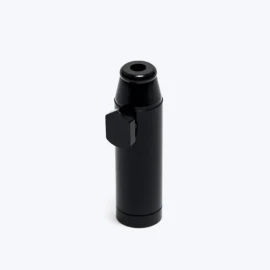Amnesia Haze Regular
60,00 €
Amnesia Haze — Regular Seeds (70% Sativa | Potent 18–22% THC)
Classic Haze genetics in regular seeds — ideal for pheno-hunters, breeders and experienced growers who want to preserve or work with original Amnesia Haze genetics. Uplifting, citrusy, and highly potent with large indoor/outdoor yields.
Key Specifications:
- THC: typically 18–22% (reports up to ~24%) — CBD <1%
- Flowering: 10–12 weeks | Yield: up to 600–650 g/m² indoor; 650–700 g/plant outdoor
- Genetics: Jamaican × South Asian × Afghani landrace heritage — high phenotypic variability
Product Summary
| Attribute | Details |
|---|---|
| Strain Type | Regular (non-feminized) — male and female seeds |
| Sativa/Indica | ~70% Sativa / 30% Indica |
| Typical Height | Medium–tall (sativa-dominant stretch) |
| Flowering Time | 10–12 weeks |
| Indoor Yield | Up to 600–650 g/m² |
| Outdoor Yield | Up to 650–700 g/plant |
| THC Content | 18–22% (lab averages); CBD: <1% |
| Dominant Terpenes | Limonene, myrcene, caryophyllene (citrus, earth, pepper) |
| Best For | Growers, breeders, pheno-hunters, experienced cultivators |
| Special Notes | Nutrient-hungry; sensitive to humidity and pests; longer flowering than many modern hybrids |
Why Amnesia Haze Regular Still Matters
Amnesia Haze stands as one of cannabis culture’s most influential strains, emerging from the underground breeding scenes of the 1990s to become a cornerstone of modern sativa genetics. This legendary cultivar has earned its place in cannabis history through award-winning performances and its distinctive combination of soaring cerebral effects with complex citrus-forward aromatics.
Regular seeds preserve the genetic variability essential for breeding programs and long-term cultivar health. Unlike feminized varieties that limit genetic diversity, regular Amnesia Haze seeds offer breeders access to both male and female plants, enabling authentic preservation of original genetics and the development of new breeding lines. This genetic authenticity makes regular seeds invaluable for serious cultivators seeking to maintain the strain’s legendary characteristics while exploring phenotypic variations.
With THC levels consistently reaching 18–22% and yields potential of up to 650 g/m² indoors, Amnesia Haze Regular delivers both potency and productivity for experienced growers willing to invest the time and attention this sophisticated strain demands.
Genetics & Lineage — Landrace Roots Explained
Amnesia Haze’s complex pedigree traces back to three distinct landrace contributions: Jamaican sativa genetics provide the uplifting, energetic foundation; South Asian varieties contribute to the strain’s psychoactive intensity and resin production; while Afghani indica genetics add structural stability and flowering consistency. This multi-continental genetic foundation creates the high phenotypic variability that makes regular seeds so valuable for breeding projects.
The landrace heritage manifests in Amnesia Haze’s tendency to express diverse phenotypes within the same seed batch. Growers may encounter variations in flowering time (ranging from 10–12+ weeks), plant structure (from medium-height bushes to towering sativa giants), and aromatic profiles (from citrus-dominant to earthier, spice-forward expressions). This genetic diversity represents the strain’s authentic character rather than a limitation.
Amnesia Haze gained international recognition through Dutch breeding programs in the late 1990s and early 2000s, winning multiple Cannabis Cup awards and establishing itself as a benchmark sativa hybrid. The strain’s influence extends throughout modern cannabis genetics, with numerous contemporary varieties tracing their lineage back to Amnesia Haze breeding stock.
For breeders, regular seeds offer access to male plants carrying valuable traits that may be lost in feminized lines. Male selection becomes crucial for preserving desired characteristics like terpene production, flowering time, and disease resistance while enabling the development of new crosses that maintain Amnesia Haze’s legendary qualities.
Understanding Regular Seeds — Sexing, Ratios, and Breeding Possibilities
Regular seeds produce approximately equal numbers of male and female plants, typically resulting in a 50:50 ratio under normal growing conditions. Environmental factors such as temperature, humidity, nutrition, and light stress can influence this ratio, with stressed conditions potentially increasing male expression.
Plant sexing becomes essential around weeks 3–6 of vegetative growth or after switching to flowering photoperiods. Male plants develop small, round pollen sacs at nodes, while females produce teardrop-shaped calyxes with emerging white pistils. Hermaphroditic plants displaying both male and female characteristics may occur under stress conditions and require careful monitoring.
Most production growers cull male plants to prevent unwanted pollination, but breeders should carefully evaluate males for desirable traits before elimination. Superior males exhibiting strong branching, vigorous growth, intense aromatics, and resistance to environmental stress become valuable breeding stock for future crosses.
Controlled pollination enables breeders to create F1 hybrids by crossing selected Amnesia Haze females with chosen males, develop backcrosses to stabilize specific traits, or preserve genetic lines through careful selection and reproduction. Regular seeds provide the genetic foundation necessary for serious breeding programs focused on maintaining and improving Amnesia Haze characteristics.
Flavor, Aroma & Terpene-Driven Sensory Profile
Amnesia Haze’s distinctive sensory profile results from its complex terpene composition dominated by limonene, myrcene, and caryophyllene. Limonene creates the strain’s signature citrus aromatics while contributing to its uplifting, mood-enhancing effects. This terpene’s presence explains the immediate citrus burst experienced during consumption and its association with increased energy and focus.
Myrcene provides earthy, herbal undertones that balance limonene’s brightness while contributing subtle sedative qualities that prevent excessive stimulation. This terpene creates the strain’s grounding effect, ensuring the cerebral experience remains manageable rather than overwhelming.
Caryophyllene adds spicy, peppery notes that emerge prominently in the exhale, creating a complex flavor journey from citrus-forward inhale to warming, spice-laden finish. This terpene also provides potential anti-inflammatory benefits and contributes to the strain’s therapeutic applications.
The complete aromatic profile develops as bright citrus oils with underlying earthiness, accented by black pepper spiciness and subtle sweet notes. During consumption, expect a citrus-forward inhale that transitions to earthy, peppery flavors on the exhale, creating an energetic head high with creative enhancement and mood elevation.
Effects — Recreational & Medical Applications
Amnesia Haze delivers a predominantly cerebral experience characterized by rapid onset of euphoric, uplifting effects that promote creativity, focus, and social engagement. The strain’s sativa-dominant genetics create an energetic high that enhances mental clarity while providing gentle mood elevation without heavy sedation.
Users report increased motivation, enhanced creative thinking, and improved social confidence, making Amnesia Haze suitable for daytime consumption and active pursuits. The psychoactive experience can become intense at higher doses, potentially creating psychedelic-like headspace that some users find overwhelming, particularly those sensitive to THC or prone to anxiety.
Medical applications focus primarily on mood-related conditions, with users reporting benefits for depression, anxiety, chronic fatigue, and stress-related disorders. The strain’s energizing effects may help combat lethargy and low motivation associated with various medical conditions. However, the very low CBD content (<1%) means Amnesia Haze functions as a THC-dominant therapy rather than a balanced cannabinoid treatment.
Due to its high potency (18–22% THC), new users should start with minimal doses and increase gradually. Consider pairing with CBD products if anxiety sensitivity occurs, and avoid mixing with alcohol or other substances. The strain’s stimulating effects make it unsuitable for evening use in most individuals, as it may interfere with sleep quality.
Comprehensive Growing Guide
Difficulty Level & Requirements
Amnesia Haze Regular requires intermediate to advanced growing skills due to its specific nutritional demands, humidity sensitivity, and extended flowering period. Success depends on consistent environmental control, attentive feeding schedules, and patience during the lengthy flowering phase.
Soil & Substrate Preparation
Optimal growing media consists of compost-rich, well-draining mixes amended with slow-release organic nutrients. Coco coir blends provide excellent drainage and allow precise nutrient control, essential for managing Amnesia Haze’s heavy feeding requirements. Avoid waterlogged conditions that can stress plants and trigger hermaphroditic responses.
Soil amendments should include mycorrhizal inoculants to enhance nutrient uptake, perlite for drainage improvement, and organic matter such as worm castings and aged compost. pH should be maintained between 6.0–7.0 for soil grows and 5.5–6.5 for hydroponic systems.
Nutrition & Feeding Protocol
Amnesia Haze demonstrates exceptional appetite for nutrients throughout both vegetative and flowering phases. During vegetative growth, increase nitrogen levels above standard recommendations while maintaining adequate phosphorus and potassium. Transition to phosphorus and potassium-heavy feeding during flowering initiation.
Organic feeding programs using compost teas, bat guano, kelp meal, and bone meal align well with the strain’s landrace heritage while supporting sustainable cultivation practices. Monitor plants closely for nutrient deficiencies, particularly calcium and magnesium, which commonly occur during rapid growth phases.
Environmental Control
Indoor cultivation requires strong lighting systems (HID, CMH, or full-spectrum LED) with intensity appropriate for sativa genetics. Maintain temperatures between 20–24°C during lights-on periods and 18–20°C during dark cycles. Temperature stability prevents stress-induced hermaphroditism and supports optimal resin production.
Humidity management becomes critical during flowering, starting at 50–65% during vegetative growth and reducing to 40–50% during flowering to prevent mold development on dense buds. Air circulation and ventilation systems must accommodate the strain’s tendency toward substantial stretch and canopy development.
Training & Plant Management
Early training techniques including topping, FIM, and low-stress training (LST) help manage Amnesia Haze’s significant stretch during early flowering. Sativa genetics can double or triple in height after photoperiod switching, requiring adequate vertical space and support structures.
Screen of Green (SCROG) or Sea of Green (SOG) methods maximize canopy utilization and improve yields by creating even light distribution across multiple bud sites. Begin training early in vegetative growth to establish proper plant architecture before flowering stretch begins.
Flowering Timeline & Development
Flowering extends 10–12 weeks with some phenotypes requiring the full 12 weeks or slightly longer for complete maturation. Plan cultivation schedules accordingly, as rushing harvest reduces potency and overall quality.
Weeks 1–3 (Vegetative): Focus on root establishment, implement early training techniques, and establish feeding schedules.
Weeks 1–4 (Flowering): Expect significant stretch requiring trellis support and continued training. Transition to flowering nutrients.
Weeks 5–8 (Flowering): Bud development accelerates. Monitor humidity levels and implement pest prevention measures. Heavy feeding continues.
Weeks 9–12+ (Flowering): Final ripening phase. Reduce humidity further, monitor trichome development, and prepare for harvest timing based on individual phenotype maturation.
Yield Optimization Strategies
Maximize indoor yields through intense lighting, consistent training, CO₂ supplementation where possible, stable environmental conditions, and proper flush timing. Outdoor cultivation benefits from Mediterranean or temperate climates with long growing seasons extending into October.
Outdoor Cultivation Considerations
Outdoor growing requires climates supporting long flowering periods without early frost or excessive autumn humidity. Northern Hemisphere growers should expect harvest windows in late September through October, depending on latitude and local weather patterns.
Monitor for humidity-related fungal issues and implement integrated pest management strategies. Provide wind protection for tall plants while ensuring adequate air circulation around dense flowering sites.
Sustainability Practices
Implement water-conserving irrigation systems, utilize organic nutrient sources, practice companion planting for pest management, and employ composting systems for waste reduction. These approaches align with the strain’s landrace heritage while supporting environmental responsibility.
Advanced Breeder’s Corner
Plant Sexing Techniques
Accurate sexing requires careful observation during the pre-flowering period, typically beginning around week 3–6 of vegetative growth or shortly after switching to flowering photoperiods. Male plants develop small, round pollen sacs clustered at nodes, while females produce teardrop-shaped calyxes with emerging white pistils.
Pre-flowers appear first at nodes where branches meet the main stem. Males typically show sex earlier than females, often displaying pre-flowers 1–2 weeks before female characteristics become apparent. Use magnification tools for accurate identification during early development stages.
Watch for hermaphroditic expressions showing both male and female characteristics, particularly under environmental stress. These plants require immediate isolation or culling to prevent unwanted pollination of female plants.
Pollen Collection & Storage
Collect pollen from selected males during peak release periods, typically in early morning when humidity is lower. Use clean collection surfaces and allow pollen to dry thoroughly before storage. Fresh pollen maintains viability for several days at room temperature or weeks when refrigerated in airtight containers with desiccants.
Long-term storage requires freezing temperatures (-18°C) in sealed containers with moisture-absorbing materials. Properly stored pollen remains viable for months, enabling planned crosses with females from different flowering cycles.
Controlled Pollination Methods
Perform controlled crosses using isolated growing spaces or protective barriers to prevent unwanted pollination. Hand-pollination techniques using small brushes allow precise breeding control, enabling specific branch pollination while maintaining seedless flowers on the remainder of the plant.
Document all crosses thoroughly, including parent plant characteristics, environmental conditions, and desired traits being selected. This information becomes essential for evaluating offspring and planning future breeding directions.
Breeding Applications
Amnesia Haze Regular serves as valuable breeding stock for developing new sativa-dominant hybrids while preserving classic Haze characteristics. Backcrossing programs can stabilize desired traits, while outcrossing introduces genetic diversity and hybrid vigor.
Consider breeding objectives carefully: yield enhancement, flowering time reduction, pest resistance improvement, or terpene profile modification. Each goal requires different selection criteria and breeding strategies extending across multiple generations.
Troubleshooting Common Issues
Humidity & Mold Prevention
High humidity during flowering creates ideal conditions for botrytis and powdery mildew development. Reduce relative humidity to 40–50% during flowering, improve air circulation, and remove affected plant material immediately. Preventive applications of beneficial microorganisms help establish protective microbial communities.
Pest Management
Amnesia Haze shows sensitivity to common cannabis pests including spider mites, aphids, and whiteflies. Implement early detection systems using sticky traps and regular plant inspection. Beneficial insects, neem oil applications, and insecticidal soaps provide organic control options.
Nutritional Disorders
Heavy feeding requirements increase risks of both nutrient deficiencies and toxicities. Monitor leaf color and growth patterns for early problem detection. Soil pH testing helps identify nutrient lockout issues, while regular feeding schedule adjustments prevent imbalances.
Hermaphroditism Management
Environmental stress increases hermaphroditic tendencies in susceptible plants. Maintain stable temperatures, avoid light leaks during dark periods, prevent drought stress, and handle plants gently during training. Remove hermaphroditic plants immediately or use them only for planned breeding projects.
Extended Flowering Challenges
Some phenotypes require 12+ weeks for complete maturation, testing grower patience and extending cultivation costs. Monitor trichome development using magnification tools rather than relying solely on published flowering times. Harvest timing significantly impacts final potency and effect profiles.
Regular vs Feminized vs Autoflowering — Making the Right Choice
Regular Seeds
Advantages: Preserve complete genetic diversity, enable breeding programs, provide access to valuable male traits, maintain strain authenticity, and support long-term genetic stability.
Disadvantages: Require plant sexing and male management, reduce effective female plant counts, and demand more advanced growing skills.
Feminized Seeds
Advantages: Eliminate sexing requirements, ensure all plants produce flowers, provide predictable harvests, and simplify cultivation for production-focused growers.
Disadvantages: Reduce genetic variability, limit breeding possibilities, and may exhibit reduced vigor compared to regular seed offspring.
Autoflowering Seeds
Advantages: Offer faster harvest cycles, simplify photoperiod management, and provide beginner-friendly cultivation options.
Disadvantages: Typically produce smaller yields, limit training opportunities, and provide less phenotypic variation for selection purposes.
Decision Matrix
Choose Regular Seeds for: Breeding projects, pheno-hunting expeditions, genetic preservation efforts, and advanced cultivation programs prioritizing authenticity over convenience.
Choose Feminized Seeds for: Commercial production, space-limited grows, and cultivation programs prioritizing efficiency over breeding potential.
Choose Autoflowering Seeds for: Quick harvests, beginner cultivation attempts, and continuous harvest systems with limited space requirements.
Cultural Impact & Legacy
Amnesia Haze established itself as a foundational strain during the Dutch coffee shop culture expansion of the 1990s and early 2000s. Its influence extends throughout modern cannabis genetics, with numerous contemporary varieties incorporating Amnesia Haze genetics in their breeding programs.
The strain’s multiple Cannabis Cup victories and widespread commercial adoption cemented its status as a benchmark sativa hybrid. Amnesia Haze genetics appear in countless modern crosses, contributing its distinctive citrus aromatics, potent cerebral effects, and productive yields to new generations of cannabis varieties.
Today’s continued demand for original Amnesia Haze genetics among seed collectors and breeding programs demonstrates the strain’s enduring relevance in cannabis culture. Regular seeds provide access to these authentic genetics, supporting preservation efforts and enabling new breeding directions while maintaining connection to cannabis history.
Legal & Safety Considerations
Cannabis laws vary significantly between countries, states, and local jurisdictions. Research local regulations thoroughly before purchasing, possessing, or cultivating cannabis seeds. Some areas permit seed possession while prohibiting cultivation, while others restrict both activities.
Store seeds properly with clear labeling and documentation. Avoid shipping to jurisdictions where cannabis seeds or possession is prohibited. Maintain awareness of changing legal landscapes and compliance requirements in your location.
Practice responsible consumption given Amnesia Haze’s high THC content. Start with minimal doses, avoid mixing with alcohol or other substances, and never operate vehicles or machinery while impaired. The strain’s stimulating effects may cause anxiety in sensitive individuals or those prone to panic responses.
Storage & Seed Quality Management
Proper seed storage significantly impacts germination rates and genetic viability. Store seeds in cool (4–8°C), dark, low-humidity conditions using airtight containers with desiccant materials. Refrigeration provides optimal long-term storage environments for maintaining seed viability.
Seeds maintain best germination rates within 1–3 years when stored properly, though older seeds may remain viable with reduced germination percentages. Test older seed batches before committing to large cultivation projects.
Label storage containers with strain information, harvest dates, and parent plant details for breeding programs. This documentation becomes essential for tracking genetic lines and planning future crosses or preservation efforts.
Frequently Asked Questions
Are Amnesia Haze regular seeds feminized?
No—regular seeds produce both male and female plants and are intended for breeders and pheno-hunters seeking genetic authenticity and breeding potential.
How long does Amnesia Haze take to flower?
Typically 10–12 weeks, with some phenotypes requiring the full 12 weeks or slightly longer for complete maturation. Plan cultivation schedules accordingly.
What yields can I expect?
Up to 600–650 g/m² indoors and 650–700 g/plant outdoors under optimal growing conditions with experienced cultivation techniques.
What is the THC/CBD content?
THC typically ranges 18–22% with reports up to 24%. CBD content remains very low at less than 1%, making this primarily a THC-dominant variety.
Is this strain suitable for beginners?
Not recommended for novice growers due to sexing requirements, humidity sensitivity, extended flowering periods, and heavy nutritional demands.
Can I breed with these seeds at home?
Yes—regular seeds provide excellent breeding stock for home breeding projects. Implement proper isolation techniques and pollen handling procedures for successful crosses.
How should I store the seeds?
Cool, dark, dry conditions using airtight containers with desiccants. Refrigeration is recommended for long-term storage to maintain maximum viability.
Are these seeds legal in my area?
Cannabis laws vary widely by location. Research local and regional regulations thoroughly before purchasing or importing cannabis seeds.
What nutrients work best?
Compost-rich substrates with organic amendments work well. Provide increased nitrogen during vegetative growth and enhanced phosphorus-potassium during flowering. Adjust feeding schedules based on growing medium.
How do I identify males early?
Look for pre-flowers at nodes around weeks 3–6 of vegetative growth. Males develop small, round pollen sacs while females produce teardrop calyxes with emerging pistils.
This comprehensive guide provides the foundation for successful Amnesia Haze Regular cultivation while supporting breeding programs and genetic preservation efforts. The strain’s legendary status, combined with regular seed genetic authenticity, offers experienced growers access to cannabis history while enabling future breeding innovations.
Related Products
Frequently Asked Questions
Everything You Need to Know














